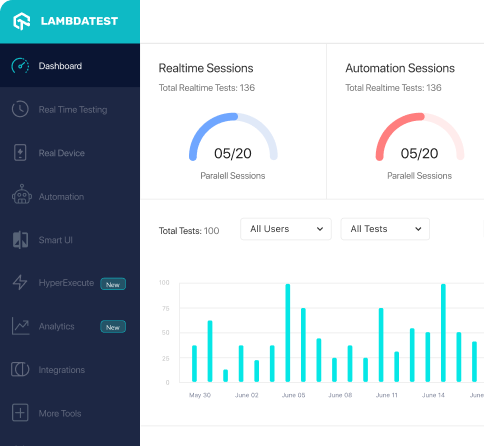How to use ImageSummary class of org.openqa.selenium.docker.internal package
Best Selenium code snippet using org.openqa.selenium.docker.internal.ImageSummary
Source:ListImages.java
...16// under the License.17package org.openqa.selenium.docker.v1_40;18import com.google.common.collect.ImmutableMap;19import org.openqa.selenium.docker.Image;20import org.openqa.selenium.docker.internal.ImageSummary;21import org.openqa.selenium.docker.internal.Reference;22import org.openqa.selenium.internal.Require;23import org.openqa.selenium.json.Json;24import org.openqa.selenium.json.TypeToken;25import org.openqa.selenium.remote.http.HttpHandler;26import org.openqa.selenium.remote.http.HttpRequest;27import org.openqa.selenium.remote.http.HttpResponse;28import java.lang.reflect.Type;29import java.util.Map;30import java.util.Set;31import static com.google.common.collect.ImmutableSet.toImmutableSet;32import static org.openqa.selenium.json.Json.JSON_UTF_8;33import static org.openqa.selenium.remote.http.Contents.string;34import static org.openqa.selenium.remote.http.HttpMethod.GET;35class ListImages {36 private static final Json JSON = new Json();37 private static final Type SET_OF_IMAGE_SUMMARIES = new TypeToken<Set<ImageSummary>>() {}.getType();38 private final HttpHandler client;39 public ListImages(HttpHandler client) {40 this.client = Require.nonNull("HTTP client", client);41 }42 public Set<Image> apply(Reference reference) {43 Require.nonNull("Reference to search for", reference);44 String familiarName = reference.getFamiliarName();45 Map<String, Object> filters = ImmutableMap.of("reference", ImmutableMap.of(familiarName, true));46 // https://docs.docker.com/engine/api/v1.40/#operation/ImageList47 HttpRequest req = new HttpRequest(GET, "/v1.40/images/json")48 .addHeader("Content-Length", "0")49 .addHeader("Content-Type", JSON_UTF_8)50 .addQueryParameter("filters", JSON.toJson(filters));51 HttpResponse response = DockerMessages.throwIfNecessary(52 client.execute(req),53 "Unable to list images for %s", reference);54 Set<ImageSummary> images =55 JSON.toType(string(response), SET_OF_IMAGE_SUMMARIES);56 return images.stream()57 .map(org.openqa.selenium.docker.Image::new)58 .collect(toImmutableSet());59 }60}...Source:Image.java
...14// KIND, either express or implied. See the License for the15// specific language governing permissions and limitations16// under the License.17package org.openqa.selenium.docker;18import org.openqa.selenium.docker.internal.ImageSummary;19import org.openqa.selenium.internal.Require;20import org.openqa.selenium.json.Json;21import java.util.Set;22public class Image {23 private final ImageSummary summary;24 public Image(ImageSummary summary) {25 this.summary = Require.nonNull("Container image summary", summary);26 }27 public String getName() {28 return summary.getRepoTags().stream()29 .findFirst()30 .orElseThrow(() -> new DockerException("Unable to find name"));31 }32 public ImageId getId() {33 return summary.getId();34 }35 public Set<String> getTags() {36 return summary.getRepoTags();37 }38 @Override...ImageSummary
Using AI Code Generation
1ImageSummary imageSummary = new ImageSummary();2imageSummary.setCreated(Instant.now());3imageSummary.setId("sha256:1234567890");4imageSummary.setLabels(Collections.singletonMap("label1", "value1"));5imageSummary.setParentId("sha256:parent1234567890");6imageSummary.setRepoTags(Collections.singletonList("test:latest"));7imageSummary.setSize(1000);8imageSummary.setVirtualSize(1000);9System.out.println(imageSummary);10ImageSummary{created=2020-06-03T07:36:30.603Z, id='sha256:1234567890', parentId='sha256:parent1234567890', repoTags=[test:latest], size=1000, virtualSize=1000, labels={label1=value1}}11JSONObject json = new JSONObject(imageSummary);12System.out.println(json);13{14 "labels": {15 }16}ImageSummary
Using AI Code Generation
1ImageSummary summary = new ImageSummary("image name", "image id", "created", "size");2ContainerSummary summary = new ContainerSummary("container name", "container id", "image", "created", "status", "ports");3ContainerInfo info = new ContainerInfo("container name", "container id", "image", "created", "status", "ports");4HostConfig hostConfig = new HostConfig("network mode", "port bindings");5NetworkSettings networkSettings = new NetworkSettings("network id", "endpoint id", "gateway", "ip address", "ip prefix length", "mac address", "network name");6PortBinding portBinding = new PortBinding("host ip", "host port");ImageSummary
Using AI Code Generation
1ImageSummary summary = new ImageSummary();2summary.setImageId("sha256:8f2f4a4d7e1c9e9f8a2e4b4c7a4a4a4a4a4a4a4a4a4a4a4a4a4a4a4a4a4a4a4a");3summary.setCreated(1600000000);4summary.setRepoTags("selenium/standalone-chrome:4.0.0-alpha-7-20200908");5summary.setLabels("org.opencontainers.image.title=Selenium Standalone Chrome");6summary.setLabels("org.opencontainers.image.description=Selenium Standalone Chrome");7summary.setLabels("org.opencontainers.image.source=Selenium 4 Tutorial:
LambdaTest’s Selenium 4 tutorial is covering every aspects of Selenium 4 testing with examples and best practices. Here you will learn basics, such as how to upgrade from Selenium 3 to Selenium 4, to some advanced concepts, such as Relative locators and Selenium Grid 4 for Distributed testing. Also will learn new features of Selenium 4, such as capturing screenshots of specific elements, opening a new tab or window on the browser, and new protocol adoptions.
Chapters:
-
Upgrading From Selenium 3 To Selenium 4?: In this chapter, learn in detail how to update Selenium 3 to Selenium 4 for Java binding. Also, learn how to upgrade while using different build tools such as Maven or Gradle and get comprehensive guidance for upgrading Selenium.
-
What’s New In Selenium 4 & What’s Being Deprecated? : Get all information about new implementations in Selenium 4, such as W3S protocol adaption, Optimized Selenium Grid, and Enhanced Selenium IDE. Also, learn what is deprecated for Selenium 4, such as DesiredCapabilites and FindsBy methods, etc.
-
Selenium 4 With Python: Selenium supports all major languages, such as Python, C#, Ruby, and JavaScript. In this chapter, learn how to install Selenium 4 for Python and the features of Python in Selenium 4, such as Relative locators, Browser manipulation, and Chrom DevTool protocol.
-
Selenium 4 Is Now W3C Compliant: JSON Wireframe protocol is retiring from Selenium 4, and they are adopting W3C protocol to learn in detail about the advantages and impact of these changes.
-
How To Use Selenium 4 Relative Locator? : Selenium 4 came with new features such as Relative Locators that allow constructing locators with reference and easily located constructors nearby. Get to know its different use cases with examples.
-
Selenium Grid 4 Tutorial For Distributed Testing: Selenium Grid 4 allows you to perform tests over different browsers, OS, and device combinations. It also enables parallel execution browser testing, reads up on various features of Selenium Grid 4 and how to download it, and runs a test on Selenium Grid 4 with best practices.
-
Selenium Video Tutorials: Binge on video tutorials on Selenium by industry experts to get step-by-step direction from automating basic to complex test scenarios with Selenium.
Selenium 101 certifications:
LambdaTest also provides certification for Selenium testing to accelerate your career in Selenium automation testing.
Most used methods in ImageSummary
Try LambdaTest Now !!
Get 100 minutes of automation test minutes FREE!!


